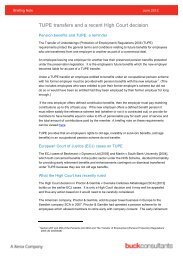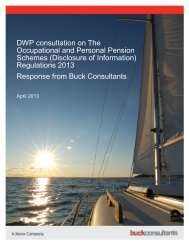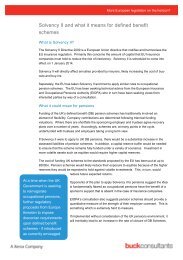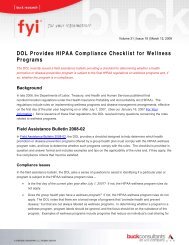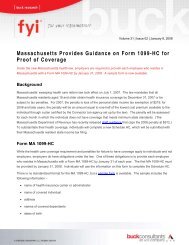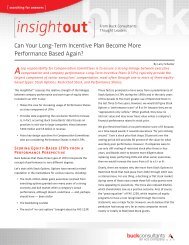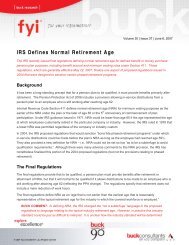Pensions News - Buckconsultants.com
Pensions News - Buckconsultants.com
Pensions News - Buckconsultants.com
You also want an ePaper? Increase the reach of your titles
YUMPU automatically turns print PDFs into web optimized ePapers that Google loves.
<strong>Pensions</strong> <strong>News</strong> – April 2013current earnings), which is above the basic level for means-tested support. Individuals will need35 years of National Insurance contributions (NICs) (or credits) to qualify for the full pension.The single-tier pension had been expected to be introduced from April 2017, but ahead of thisyear’s Budget, the Chancellor announced that it would in fact begin in 2016.The abolition of S2P means that contracting-out for defined benefit schemes will cease, and inlight of the Chancellor’s announcement, this will now happen sooner than expected. Thismeans that sponsoring employers, and members, of contracted-out schemes will face an NICincrease. The Government plans to give sponsoring employers of such schemes, limitedpowers to change scheme rules for these purposes, without trustee consent. This means thatemployers may choose to reduce benefits and/or increase member contributions. Furtherdetails on this are now awaited.This reduced timescale for ending contracting-out is likely to only increase pressure on theDWP to reveal its plans for defined ambition schemes (see section 3.1) as employers considerhow to deal with the end of contracting-out.The Government has also <strong>com</strong>mitted to review the state pension age (SPA) every five years,from the next Parliament, to ensure that SPA keeps track with increased life expectancy. Anychanges to SPA would require at least ten years’ notice before implementation.The DWP has published a draft <strong>Pensions</strong> Bill that legislates for the provisions in the WhitePaper.12) Call for evidence on NEST restrictionsWhen the National Employment Savings Trust (NEST) was created, it was designed to fill aperceived gap in the market to ensure that everyone eligible for automatic enrolment hadaccess to a low-cost pension scheme. The design of NEST meant that certain constraints wereimposed on the scheme. As it is targeted at low to moderate earners, and those employers withhigh level of staff turnover, there is an annual limit on contributions and also restrictions ontransferring in and out of NEST. The annual contribution limit is £4,400 in 2012/13 earningsterms.Following concerns that medium-sized employers could face limited choices on automaticenrolment, because of the restrictions, the DWP has published a call for evidence on lifting theannual contribution limit and the transfer restrictions. The DWP has proposed eight possiblealternative approaches for consideration that modify or remove the restrictions.The call for evidence ran until 28 January 2013. Many of the responses appear to have beensupportive of moves to abolish the restrictions, although perhaps not surprisingly, the insuranceindustry seems to be pressing for the limits to be retained. It is understood that the DWPintends to publish a summary of responses in the spring.13) Consultation on changes to NESTNEST was established by a piece of legislation known as an Order. NEST is a trust-basedoccupational pension scheme and the NEST Order is the equivalent of the Trust Deed. The7




